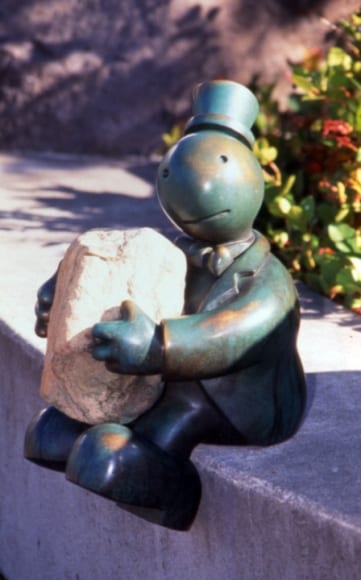About the Work
Feats of strength is an art piece comprised of multiple statues placed around a walkway, all doing various activities. The statues are all humanoid in nature, but not perfect humans. Standing at about two feet tall, they all have dots for eyes and a line for a mouth, with no nose. They all have various degrees of clothing, some full clothed, and some with no pants, genitals fully exposed. One is standing on a boulder holding a large rock high above its head while another one is sitting holding a smaller rock in its lap. One is sleeping, one is holding up a ledge, and three more are transporting a very large rock through the walkway. On top of the rock being transported, is a smaller statue, just a few inches tall, standing on top of an oversized panny. The penny is likely a notion waved at the material that the statues have been cast with, being bronze.
Pennies are typically known for being made of copper, and bronze is comprised of 88% copper and 12% tin. When casting with bronze there are three positives and three negatives of the piece created, and with 8 statues, that’s 40 pieces in total, and that’s assuming he was comfortable with the first casting of each piece. Keeping that in mind and the fact that the work was completed in 1999, it is likely that the work was started in 1998, even possibly 1997. The rocks in the environment are all made of sandstone, a common rock found in the San Juan Islands, and a note from Tom Otterness himself confirms that the statues represent men and women working in the San Juan Islands today.
About the Artist
The artist, Tom Otterness, was born in Wichita, Kansas in 1952 and raised there through high school. After completing high school in 1970 he moved to New York City. There he showed interest in the city’s art scene and began getting involved with it. He studied at the Student’s Art League till 1973 where he participated in the Whitney Independent Study Program. In the completion of his schooling he involved himself more and more with the artist community in New York. He became a member in an independent artist community called “Collaborative Projects” In 1977. From there his career took off with his substantial involvement in Colab’s Times Square Show, what some called “the first Avant Garde show of the 80s.” Other works building his reputation include the Humpty Dumpty Balloon floated in the 2005 Macy’s Thanksgiving Day parade. Although the breadth of his meadiums is notable, he is most famous for his bronze castings. His castings vary in size from ten inches tall to five feet tall. He has also done playgrounds in his aesthetic and architectural embellishment pieces which are amongst his earliest works. Tom Otterness is an artist who has remained relevant for decades and whose works are diverse in medium and versatile in audience. His contributions to the art world are Impressive and and as such, we are thankful to have “feats of strength” grace our WWU campus.
Possible Influences
During the 90s, a lot of things happened that strongly influenced the world as well as movements in art. As inspiration seems to come from big events. In 1990, the berlin wall fell.
1990-1991, Operation Desert Storm (or the Gulf War) went on, as well as the collapse of the Soviet Union, which ended the Cold War. War has affected artistic practice and continues to affect the artist to this day. In the 90s there seemed to be a lot of artist searching for meaning of what art is. For example, Damien Hirst’s 1991 piece titled “The Physical Impossibility of Death in the Mind of Someone Living” directly brings about questions of life and death, by experiencing a shark suspended in formaldehyde. The most important part of this piece is the experience of it, as many artists in the 90s seemed to follow down that road of thinking as well. Another artist by the name of Jeff Koons created a piece entitled “Balloon Dog”, playing off of “Kitsch”, items of poor taste excessively bright and showy, eliciting some sort of sentimentality. It pushes the lines of what art is, and lets us have an experience surrounding it. Lots of people were interested in a artwork that people could experience, and that is something that Tom Otterness shows a lot in his work. His sculptures can be seen interacting with the landscape, as well as the people who are there to experience them.
Created by Isaiah Pouch, Bo Baird, and Mary Boyle
Artist research, Coordination ~ Bo Baird
Piece research, Website organization ~ Isaiah pouch
Contextual research, Paintings ~ Mary Boyle
Photographs by Rod del Paza
sources
“Feats of Strength.” Tom Otterness, www.tomostudio.com/artworks/feats-of-strength?view=slider#6.
MWeb Problem, www.artswa.org/mwebcgi/mweb?request=record;id.
Briarcroft. “Tag: Feats of Strength.” Barnstorming, briarcroft.wordpress.com/tag/feats-of-strength/.
Arning, Bill. Otterness. Marlborough Gallery, 1997.
Pearson, Steve. “The Year 1999 From The People History.” What Happened in 1999 Inc. Pop Culture, Prices and Events, www.thepeoplehistory.com/1999.html.









Leave a Reply